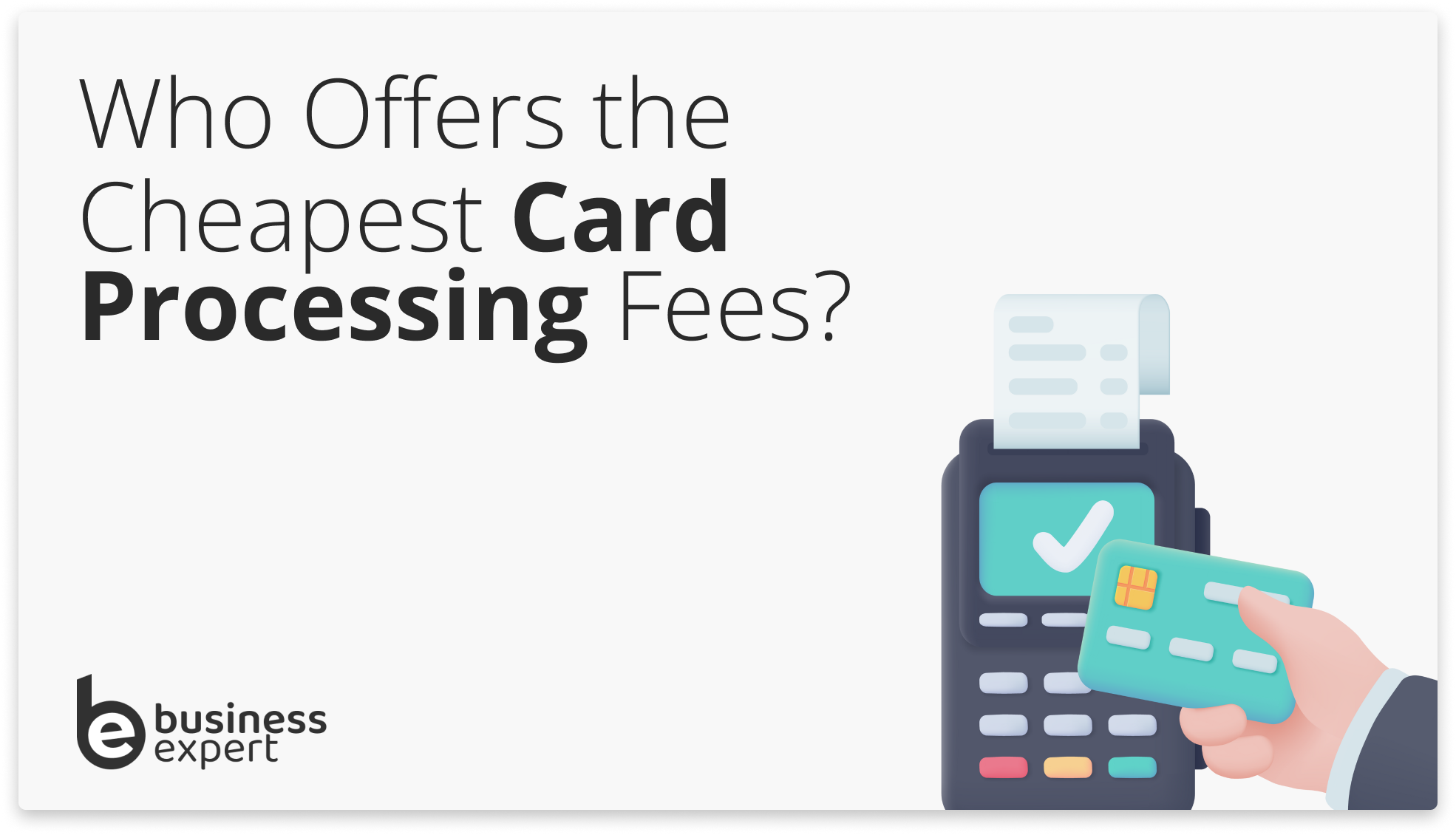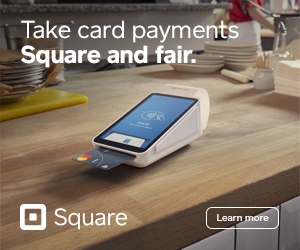In a world where profit margins can be slim, the choice of a credit card processor can significantly impact a company’s bottom line. I’ve researched those companies offering the best possible card processing fees to UK businesses, assessing their reviews, customer service, features and more.
It’s worth pointing out that the real ‘cheapest’ for you is going to depend on your business’s industry, sales volume and typical transaction size, to name a few factors.
That notwithstanding, these companies stand out for their fair pricing and ability to quote very competitively when the fit is right.

Square Reader (2nd Generation)

SumUp Solo Card Reader and Printer

Revolut Reader


Who Offers the Cheapest Credit Card Processing Fees in 2025?
| Provider | Trustpilot Rating | Monthly Cost | UK Card In-Person Transaction Rate | UK Card Online Transaction Rate | Learn More |
| Square | ⭐⭐⭐⭐ (4.1) | £0 | 1.75% | 1.4% + 25p | Visit Square |
| SumUp | ⭐⭐⭐⭐ (4.2) | £0 – £19+VAT | 1.69% (0.79% for 30k+) | 0.79% – 2.5% | Visit SumUp |
| Revolut | ⭐⭐⭐⭐ (4.2) | £0 – £79+ | 0.8% + 2p | 1% + 20p | Visit Revolut |
| Elavon | ⭐⭐⭐⭐⭐ (4.6) | £0 – £62 | 0.99% – 1.75% | 0.99% – 1.99% + 12p | Visit Elavon |
| Stripe | ⭐⭐⭐ (2.6) | £0 | 1.4% + 10p | 1.5% – 1.9% + 20p | Visit Stripe |
| WorldPay | ⭐⭐⭐⭐⭐ (4.6) | £17.50 – £22.50 | 1.5% | 1.5% | Visit WorldPay |
| Tyl by Natwest | ⭐⭐⭐⭐⭐ (4.7) | Approx £15 – £63+VAT | 1.5% | 1.5% | Visit Tyl by Natwest |
| Zettle | ⭐⭐⭐ (2.9) | £0 | 1.75% | 1.75% | Visit Zettle |
| Retail Merchant Services | ⭐⭐⭐ (3.1) | Quote-based | Quote-based | 0.79% + 10p | Visit RMS |
Square
For face-to-face transactions using card readers, Square charges a fee of 1.75%. For online transactions, the rate is slightly 1.4% plus 25p per transaction.
Square does not impose a monthly fee for its standard pay-as-you-go service, making it an accessible option for businesses of all sizes. Additionally, Square provides a comprehensive suite of products, including advanced card readers and integrated online sales tools, starting from a competitive price point.

Square’s commitment to its customers is further demonstrated through its promise of next-day payouts, continuous support, and consistent fee structure.
Pros:
- No monthly fees: Square offers a cost-effective pay-as-you-go model.
- Competitive transaction rates: Attractive fees for both in-person and online sales.
- Comprehensive sales tools: A wide range of products to support various business needs.
Cons:
- Higher fees for online transactions: Online sales incur a slightly higher fee.
- Limited lower rate options: Unlike subscription models, there are no lower rates for higher volumes without custom negotiation.
Why we like it: Square stands out for its user-friendly approach, offering a straightforward, efficient way to process payments across multiple channels. Its no-monthly-fee model, coupled with a robust suite of tools for business management, makes Square an excellent choice for businesses seeking a reliable and versatile payment processing solution.
SumUP: Best for Businesses Taking 30k+ per year
For in-person payments like card readers and tap-to-pay, the fee is 1.69% per transaction, or lower if you subscribe. For digital payments like invoices and online store transactions, it’s 2.5%.
However, businesses that make £30,000 or more yearly, save an average of 40% on fees bringing those in-person transaction payments down to 0.79% each! Plus, you can cancel anytime. This is the best rate we’ve heard of for a no-contract solution.
Pros:
- 7am next-day payouts
- Fixed Fees
- Dedicated Support
- Full invoicing software
Cons:
- The transaction fees can go up to 2.5%.
- Limited advanced features
Why we like it:
SumUp’s appeal lies in its simplicity and affordability. It’s an excellent choice for businesses that need a straightforward, no-fuss solution for accepting card payments.
Revolut Payments
The Revolut Reader costs £49 plus shipping, and once you’ve paid, it’s yours. There’s no monthly fee; you only pay a fee for each transaction.
Fees for UK consumer cards are 1% + £0.20, and for all international and commercial cards, it’s 2.8% + £0.20. Revolut offers simple, flat fee pricing per transaction, making it easy to understand. For businesses with high monthly volumes, Revolut also provides custom plans to fit your needs.
You will need a Revolut Business account though, which may put off some who don’t want a second account.
Pros:
- Rates starting as low as 0.8% + 2p
- The platform includes banking, currency exchange, and expense management
- Accept payments in 25+ currencies into dedicated currency accounts.
- Get paid directly to your Business account with next-day settlement.
Cons:
- Monthly fee for premium features
- Customer service concerns: Some users have reported challenges in getting timely support
- The Card Machine is very simple
- No offline payments
Why we like it:
Revolut stands out for its competitive transaction fees and comprehensive suite of financial services, making it a strong option for businesses ready to use Revolut as their primary bank account. It is particularly beneficial for businesses that operate internationally, providing an efficient and cost-effective method for handling global transactions.
While it may not offer the advanced POS software capabilities seen in solutions like Square, and its card machine is somewhat basic, Revolut’s global financial services and attractive pricing structure make it a compelling choice for businesses aiming to streamline their financial processes across multiple countries.
Elavon
Elavon is a leading global payment processor offering a wide range of merchant services, including credit and debit card processing, mobile and online payment sol
For face-to-face payments, there’s no monthly fee, with transaction fees starting from 1.75% and a one-off device cost of £29.
Monthly plans for more advanced features start from £15, with transaction fees from 0.99%.
For online payments, the monthly gateway fee starts at £25, with transaction fees from 0.99%, or a pay-as-you-go option with a 1.99% transaction fee and a £0.12 click-fee. Elavon provides devices and services for both in-person and online payments, supporting b
Pros:
- Competitive transaction rates.
- Elavon supports a vast array of payment methods.
- Elavon is known for its reliable customer service
Cons:
- Variable fees
- While Elavon offers competitive transaction rates, some businesses may incur setup fees or need to purchase hardware.
Why we like it:
Elavon’s global reputation for reliability makes it a standout choice for businesses prioritising security and customer service. Its competitive rates, coupled with a wide range of supported payment methods, provide a flexible and cost-effective solution for businesses aiming to streamline their payment processing systems.
Stripe
Stripe offers a comprehensive payment platform with a simple, pay-as-you-go pricing model for businesses of all sizes. There are no setup fees, monthly fees, or hidden fees.
For standard UK card transactions, the cost is 1.5% + 20p, while for EU cards, the fee is 2.5% + 20p. Stripe also provides custom pricing options for businesses with large payment volumes or unique business models, including volume discounts and multi-product discounts.
The platform supports over 135 currencies, local payment methods, and offers tools for creating optimised checkout flows, managing subscriptions, and handling invoices, all with the aim of helping businesses grow by automating revenue and finance operations.
Pros:
- No monthly fees: Stripe operates on a pay-as-you-go pricing model, eliminating monthly fees and making it accessible for businesses with varying transaction volumes.
- Comprehensive API: Stripe’s extensive API allows for high levels of customisation, enabling businesses to tailor the payment process to their specific needs.
- Global support: Stripe supports a wide range of currencies and payment methods, making it ideal for businesses with an international customer base.
Cons:
- Higher fees for international cards.
- Complexity for non-developers: While Stripe’s customisability is a significant advantage, businesses without technical expertise may find the platform challenging to navigate.
Why we like it:
Stripe’s strength lies in its powerful API and the ability to create a customised payment experience. It’s a top choice for businesses looking to integrate payments seamlessly into their websites or apps, offering scalability and flexibility to grow with your business.
WorldPay
Like many providers, Worldpay doesn’t give fixed prices but quotes per the turnover value of your monthly card transactions, with businesses having higher card turnover generally receiving lower fees.
For example, a retail business with an average transaction value of £25 could see in-person debit card fees starting from 0.60% for a £25,000 turnover, decreasing to 0.30% for a £10,000,000 turnover. Credit and business card fees follow a similar pattern, decreasing as turnover increases. Additional fees include a 4.5p authorisation fee per transaction, a £20 chargeback fee, a £5 monthly PCI DSS service fee, and a minimum monthly service charge of £15. Exact rates require a bespoke quote to accommodate the specific needs of your business.
Pros:
- Fixed monthly fee
- Wide range of payment options
- Robust security measures
Cons:
- Monthly fees: Unlike some of its competitors that offer pay-as-you-go pricing, WorldPay’s model includes monthly fees, which might not be ideal for businesses with low transaction volumes.
- Contractual commitments
Why we like it:
WorldPay’s appeal lies in its comprehensive range of services and its reputation for reliability. It’s well-suited for businesses looking for a dependable payment processing partner that can offer a wide array of payment methods backed by robust security measures.
Tyl by Natwest
Tyl by NatWest tailors its fees based on your business’s size and type, offering straightforward pricing for UK-based businesses. For annual card payment values up to £50k, Tyl provides a single transaction charge of 1.5% (excluding American Express, which varies by industry).
For businesses over £50k in annual card payments, Tyl offers custom pricing to suit larger business needs. There are no charges for cancellations, international card payments, refunds, or authorisation fees. Special promotions include no monthly fees on the e-commerce gateway for the first 12 months, usually costing £14.95+VAT per month. Tyl also offers a range of card machines with the first three months free for new customers under a minimum 12-month contract.
Pros:
- Competitive pricing: With a clear and competitive pricing structure, Tyl is designed to be affordable for businesses of all sizes.
- Next day settlement: Tyl offers next day settlement, improving cash flow for businesses by ensuring they have quick access to their funds.
- Support from NatWest: Being part of a major banking group, Tyl customers benefit from the security and support of a well-established financial institution.
Cons:
- Limited by geography: Tyl’s services are primarily aimed at UK businesses, which might limit its appeal to companies with a broader international presence.
- Monthly fee: Although competitive, Tyl does charge a monthly fee, which businesses need to consider when calculating their overall costs.
Why we like it:
Tyl by NatWest, underpinned by the reputable British bank NatWest and developed by Pollinate using Clover hardware, offers a streamlined payment solution for small businesses. Its pricing model is designed with simplicity and affordability in mind, particularly beneficial for those already banking with NatWest and seeking to consolidate their financial services.
For businesses with an annual card payment value up to £50K, Tyl proposes a straightforward transaction fee of 1.5% for Visa and Mastercard, with bespoke rates for American Express cards. This competitive rate is slightly higher than Revolut’s but remains cheaper than some competitors, providing solid value for smaller operations. The over £50K revenue plan introduces custom transaction fees, accommodating larger businesses with volume-based pricing.
Tyl’s approach to hardware is distinct; rather than selling card readers, it opts for a rental model, aligning more closely with traditional merchant account providers than mobile alternatives like Stripe and Zettle. This includes a range of devices from pocket-friendly options to full POS systems, with the first three months free, further enhancing its appeal to new customers. Despite this, the addition of a monthly fee for the online payment gateway, waived initially, should be factored into long-term costs.
Notably, Tyl’s commitment to transparency is evident in its straightforward fees structure, excluding hidden charges for authorisation or refunds. However, businesses must be prepared for additional costs for Amex transactions and PCI compliance on higher revenue plans.
Zettle
Zettle by PayPal is a financial technology company that provides mobile payment solutions and point-of-sale systems to small businesses, enabling them to accept payments, track sales, and manage transactions efficiently.
It’s pricing is fairly similar to Square: for all transactions, whether they occur in person or online, Zettle applies a flat rate of 1.75%.
Payment links and Zettle invoices are both charged at 2.5%.
Pros:
- No monthly fees: Zettle offers its services without any recurring monthly charges.
- Simple flat-rate pricing: A consistent rate of 1.75% for all types of transactions.
- Versatile payment acceptance: Supports a broad spectrum of payment methods.
Cons:
- One-size-fits-all rate: The flat rate might not favour businesses with high transaction volumes looking for volume discounts.
- Limited advanced features: Businesses in need of more sophisticated functionalities may find Zettle’s offerings somewhat basic.
Why we like it: Zettle’s appeal lies in its simplicity and straightforwardness, offering a hassle-free solution for businesses to accept payments both in-person and online. The no-monthly fee structure, combined with a flat transaction rate, makes Zettle an excellent choice for startups and small businesses aiming for budget-friendly payment processing solutions.
Retail Merchant Services (RMS)
Retail Merchant Services (RMS) offers some of the lowest transaction fees in the market for card payments, charging 0.4% for debit cards and 0.8% for credit cards. Its online transaction fees are also competitive at 0.79% + 10p.
Despite these attractive rates, RMS has been critiqued for its lack of transparency in pricing, contract lock-ins with high exit fees, and less-than-ideal customer service experiences.
The company, acting as an intermediary for Elavon, caters to small and medium-sized businesses across retail and hospitality sectors but falls short in offering a competitive edge when compared to other payment service providers.
Pros:
- Custom pricing model: Tailored rates that accommodate the specific needs of each business.
- Competitive rates for online transactions:
Cons:
- Customer Service
- Fees may vary significantly between businesses based on their negotiation and specific needs.
Why we like it: Retail Merchant Services stands out for its tailored approach to payment processing fees, offering businesses a personalised solution that reflects their transaction volumes and operational needs. The focus on custom pricing ensures that businesses can benefit from competitive rates, making RMS a preferred choice for merchants seeking flexibility and cost-efficiency in their payment processing services.
Card Processing Fee Pricing Models
Card processing providers use a variety of pricing models, each with its advantages and disadvantages.
The most common pricing models include
- Flat Rate: A fixed percentage of the transaction value and/or a flat fee per transaction. It offers simplicity and predictability but may not be the most cost-effective for high-volume businesses.
- Interchange-Plus: Merchants pay the interchange fee set by card networks plus a markup set by the processor. It offers transparency and is often cost-effective for businesses with large transactions or varying card types.
- Interchange-Plus-Plus: Builds upon Interchange+ by providing even more detailed breakdowns of transaction costs. Your fees will include the interchange fee, the processor’s markup, and other charges associated with your card transactions. These additional fees may include scheme fees, network fees, and other processing costs.
- Tiered Pricing: Transactions are categorised into tiers (qualified, mid-qualified, non-qualified) based on card type and processing method. While simple to understand, this model can lead to higher overall fees and a lack of transparency.
- Subscription-Based: Merchants pay a flat monthly fee for processing services, regardless of transaction volume. This model suits businesses with consistent transaction patterns and can offer cost savings for high-volume merchants.
- Blended: Merchants are charged a simple fixed percentage of each transaction, regardless of the fees charged by card issuers. A blended pricing model includes all of the various fees within payment processing – individual interchange, card scheme, and processing fees – in one fixed figure.
Types of Card Processing Fees
Businesses pay different fees when processing credit card transactions.
Understanding the types of card processing fees is essential to managing your expenses and negotiating more favourable terms.
The exact fees you will pay will depend on your provider and your card turnover. However, they could include the following:
Interchange Fees
These are the primary fees paid to the card-issuing bank and are determined by the card networks (Visa, Mastercard, etc.).
Interchange fees vary based on factors such as the type of card used or the transaction method.
For example, manually-entered and online payments often have a higher transaction rate as they have a higher risk of fraud.
These fees are usually expressed as a percentage and range between 0.2% to 1% of the transaction value.
Transaction Fees
Transaction fees are charged by the payment processor each time a transaction is processed. These fees can be a combination of a percentage of the transaction value and a fixed charge per transaction.
The exact amount can vary depending on the processor, the type of transaction, and the risk associated with the transaction. They are a crucial consideration for merchants as they directly impact the cost per sale.
Example Transaction Fees
- For Standard Card-Present Transactions:
- Percentage Fee: 1.2% of the transaction value.
- Fixed Fee: 10p per transaction.
- For Online or Card-Not-Present Transactions:
- Percentage Fee: 1.9% of the transaction value.
- Fixed Fee: 20p per transaction.
- For International Transactions:
- Percentage Fee: 2.5% of the transaction value.
- Fixed Fee: 30p per transaction.
Card Scheme Fees
Card scheme fees are imposed by the credit card networks, such as Visa or Mastercard, for using their network. These fees are typically a small percentage of each transaction and are paid to the card networks to cover various services like fraud monitoring, network maintenance, and the provision of benefits like reward points or travel insurance.
Example Card Scheme Fees:
- Visa/Mastercard Standard Transactions: Typically around 0.1% to 0.12% of the transaction value.
- High-Value or Business Card Transactions: Slightly higher, often around 0.13% to 0.15% of the transaction value.
- Additional Benefits Cards: For cards offering rewards or travel insurance, fees can be approximately 0.15% to 0.2% of the transaction value.
Amex Fees
You’ll pay Amex fees when a customer uses an American Express card to pay for your goods or services.
They include interchange fees paid to American Express and any additional fees imposed by the merchant account provider for processing Amex transactions.
Amex fees typically range between 1% and 2%.
As American Express operates its own payment network separate from other card networks like Visa and Mastercard, merchants may incur higher processing fees for accepting Amex cards due to its unique fee structure and brand recognition.
Assessment Fees
Assessment fees are charges card networks impose for using their payment infrastructure and network.
They’re sometimes referred to as network fees or network access fees and are typically a small percentage of the transaction volume.
Merchant Account Provider Fees
This category includes various fees charged by the merchant account provider or payment processor. These fees may include:
- Set-up Fee: Your merchant account provider may charge a one-off fee when you begin processing card payments. Set-up fees usually range between £50 and £200.
- Transaction Authorisation Fee: Charges incurred each time a merchant requests authorisation for a credit card transaction. These fees range between 1 to 3p per transaction and cover the cost of verifying the availability of funds in the customer’s account.
- Transaction Fee: A flat fee or percentage of the transaction amount charged for each payment processed. Percentages usually range between 1.4 % and 3.6%.
- Discount Rate: A percentage of each transaction amount the processor deducts as its fee. Also known as merchant service charges, they typically range between 0.2% and 0.3%
- Monthly Account Fee: A fixed monthly charge for providing account management services. Fees range between £5 and £15 per month, with some providers offering free accounts.
- Monthly Minimum Fee: The merchant must pay a minimum fee each month and are charged the difference if their transaction fees don’t meet this minimum. This fee is usually between £10 and £20 per month.
- Gateway Fee: If transactions are processed online, a fee might apply for using the payment gateway that facilitates online transactions.
- PCI Compliance Fee: A fee for ensuring the merchant complies with Payment Card Industry (PCI) data security standards. This fee is typically between £2.50 and £5 per month.
Incidental Fees
These are additional charges that may occur depending on specific circumstances:
- Chargeback Fee: When a customer disputes a transaction and initiates a chargeback, a fee is charged to the merchant to cover administrative costs. Fees can range between £10 and £25 per chargeback.
- Refund Fee: Some processors charge a fee for processing refunds to cover administrative costs. Refund fees are usually between 20p and £1.50.
- Non-Compliance Fee: If a merchant fails to meet PCI compliance standards or violates terms of service, they may incur additional fees.
- Currency Conversion Fee: These fees cover the cost of converting the transaction amount from the customer’s currency to the merchant’s currency.
- Fast Payouts: Instant or next-day access to funds may incur additional fees of around 1% and 2% of the transaction amount.
- Additional Features: Payment processors may offer optional services to merchants, such as fraud detection, reporting capabilities, and recurring billing services for an additional charge.
Hardware Costs
These fees relate to the hardware you use to facilitate transactions and improve customer service.
They include:
- Card Machine Fees: Charges associated with the rental or purchase of card terminals. Depending on your machine, upfront costs range between £19 to £200+.
- POS Fees: An upfront or monthly fee for purchasing or renting an all-in-one point-of-sale (POS) system. Prices start from £100.
Factors That Affect Card Processing Fees
Your card processing fees are based on several factors, including
- Industry and business type: Businesses in high-risk industries, such as online gambling or pharmaceuticals, may face higher fees due to the increased risk of fraud and chargebacks. On the other hand, businesses with a long-standing history of reliable transactions may be offered more competitive rates.
- Transaction Volume and Value: Merchants processing a higher volume of transactions or larger transaction amounts may negotiate lower processing fees due to the potential for increased revenue for the processor.
- Geographical factors: Cross-border transactions or accepting cards issued from foreign banks usually incur additional fees. Even within the same country, regional regulations can lead to variations in rates.
- Card Type and Brand: Different cards, such as debit, credit, corporate, or rewards cards, carry varying interchange rates set by card networks.
- Transaction Method and Risk: Card-present transactions, where the card is physically present during the transaction, are generally considered less risky and may have lower processing fees compared to card-not-present transactions, such as online or over-the-phone purchases, which pose higher fraud risks.
- Merchant account vs. payment service providers: Using a dedicated merchant account usually results in lower processing fees compared to utilising a third-party payment service provider like PayPal or Square. However, merchant accounts often have additional costs like monthly fees and setup costs that you’ll need to account for.
- Merchant Category Code (MCC): Different MCCs may have different interchange rates. For example, MCCs associated with industries prone to chargebacks or fraud may face higher interchange rates and processing fees.
- Processing Technology: The technology used for processing, such as traditional terminals versus mobile or contactless payment solutions, can impact processing fees.
- Merchant Agreement: Merchants can negotiate discount rates, transaction fees, contract terms, and additional services to optimise their fee structure and minimise costs.
- Regulatory Compliance and Security: Failure to comply with PCI DSS standards may result in non-compliance fees, fines, or increased risk of data breaches, leading to reputational damage and financial losses for merchants.
Cross-Border Fees: A Hidden Cost of Credit Card Transactions
Cross-border fees are additional charges levied on transactions involving international elements. These fees are typically a percentage of the transaction, and they can add up quickly, especially when combined with other fees like interchange and assessment fees. Credit card networks impose cross-border fees, which are non-negotiable.
Several factors can influence the imposition and size of cross-border fees, including:
- Card issuer’s country: Transactions involving cards issued outside your home country will generally attract cross-border fees.
- Currency conversion: If a transaction requires currency conversion, this often incurs an additional fee.
- Network policies: Each credit card network has its own set of rules and fees for cross-border transactions, which can change periodically.
There are a few things you can do to manage the impact of cross-border fees, including:
- Multi-currency processing: Consider adopting a payment processing solution that allows you to accept payments in multiple currencies, thereby eliminating the need for currency conversion in some cases.
- Localised payment methods: Offering local payment options can sometimes circumvent the need for cross-border fees, making your products or services more attractive to international customers.
- Fee monitoring and transparency: Choose a payment processor that provides detailed reporting on cross-border fees, enabling better tracking and accounting.
- Strategic pricing: If a large proportion of your business involves international transactions, consider this when developing your pricing strategy to offset the additional costs.
Ways to Reduce Card Processing Fees
If you accept card payments, you won’t be able to avoid paying fees completely. However, you may be able to reduce the amount you pay by doing the following:
- Negotiate Rates: If you have a high transaction volume or process high-value payments, you may be able to negotiate lower transaction fees.
- Choose the Right Provider: Compare offerings from different payment processors to find one that offers competitive rates and transparent fee structures tailored to your business needs.
- Optimise Card Acceptance: Encourage customers to use lower-cost payment methods like debit cards instead of credit cards whenever possible. Consider implementing surcharges to offset costs.
- Monitor Rates: Stay informed about changes in interchange rates and card network fees to identify opportunities for cost savings and adjust your pricing strategies accordingly.
- Invest in Technology: Consider using modern payment processing technology and equipment that supports efficient and secure card transactions, such as POS systems, contactless payment terminals, and mobile payment solutions.
- Reduce Chargebacks: Implement measures to prevent and manage chargebacks effectively, such as improving customer service, clarifying billing descriptors, and resolving disputes promptly.
- Maintain PCI DSS Compliance: Adhere to data security requirements to protect cardholder data and avoid non-compliance fees.
- Batch Processing: Settle transactions in batches rather than processing them individually throughout the day to reduce per-transaction costs and streamline reconciliation processes.
- Improve Data Entry: Ensure accuracy when processing transactions to minimise errors and avoid unnecessary fees.
- Educate Staff: Train your staff to understand card processing fees, chargeback procedures, and best cost mitigation practices. Empower them to identify potential issues and effectively address customer inquiries about payment processing.
FAQs
UK regulations, effective from January 2018, prohibit surcharging customers for using specific payment methods like credit cards, debit cards, Apple Pay, and PayPal.
In the UK, transaction fees typically consist of interchange fees, card scheme fees, and a margin added by the payment processor, cumulatively ranging from 1.5% to 3.5% per transaction.
Flat fees in credit card processing can include fixed costs like monthly account maintenance fees and software subscription charges, payable irrespective of transaction volume.
Incidental fees are additional charges activated by specific events, such as chargebacks or non-compliance with Payment Card Industry (PCI) Data Security Standards.
To minimise credit card processing fees, businesses can negotiate lower rates with payment processors or encourage the use of payment methods with lower associated costs.
To minimise credit card processing fees, businesses can negotiate lower rates with payment processors or encourage the use of payment methods with lower associated costs.
Failure to comply with UK regulations can result in financial penalties and may jeopardise a business’s ability to process electronic payments in the future.
Blended pricing (meaning a fixed percentage) is most suitable for businesses looking for simplicity and certainty. The ease of onboarding and competitive prices make this option even more attractive. For businesses with higher transaction volumes or more complex needs, you’ll want to use Interchange Plus or ++. The rates come down from 1.5% to as low as 0.4% for certain types of transactions, but you’ll need to be on a long-term contract to get this and have a decent turnover.
Yes, it is generally possible to switch from a different pricing model to blended pricing. Still, the process may vary depending on your payment processor and the terms of your existing agreement.
Blended Pricing combines all fees into one higher rate for international transactions, while Interchange Plus Pricing separates and details actual fees, which may vary for international transactions.
Blended and interchange plus pricing generally don’t handle chargebacks differently from other pricing models.
The complexity of the payment ecosystem, the need for secure transactions and the processing of large transaction volumes all contribute to the overall cost. Additionally, interchange fees are influenced by factors such as risk management, regulatory compliance, and the competitive landscape among payment providers.
Merchant fees are what businesses pay to process card payments and cover costs like transaction processing and network fees. Interchange fees are a specific part of merchant fees. They’re what banks pay each other when processing card transactions.
Online transactions often incur higher interchange fees due to the increased risk of fraud and chargebacks associated with card-not-present transactions. In contrast, in-person transactions generally have lower interchange fees because they are considered lower risk, making them more cost-effective for businesses.



